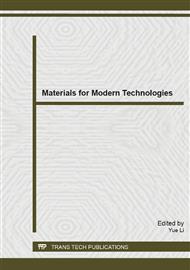[1]
Sihvola, A., & Jin Au Kong. Effective permittivity of dielectric mixtures, IEEE Trans. on Geos. Remote Sens. 26 (1988) 420-429.
DOI: 10.1109/36.3045
Google Scholar
[2]
R. Tao and J. M Sun. Three-dimensional structure of induced electrorheological solid Phys. Rev Lett. 67(1991) 398-401.
DOI: 10.1103/physrevlett.67.398
Google Scholar
[3]
Skirta, E. A., & N. A. Khizhnyak. Dielectric properties of bulk anisotropic structure and multiphase mixture. Electromagnetics. 13(1993) 389-405.
DOI: 10.1080/02726349308908360
Google Scholar
[4]
T. C. Halsey and W. Toor. Structure of electrorheological fluids. Phys. Rev. Lett. 65 (1990) 2820-2823.
DOI: 10.1103/physrevlett.65.2820
Google Scholar
[5]
R. Tao. Electric-field-induced phase transition in electrorheological fluids Phys. Rev. E 47(1993) 423-426.
DOI: 10.1103/physreve.47.423
Google Scholar
[6]
Tinga, W. R., & W. A. G. Voss. Generalized approach to multiphase dielectric mixture theory. Journal of Applied Physics. 44(1973) 3897-3902.
DOI: 10.1063/1.1662868
Google Scholar
[7]
T. J. Chen, R. N. Zitter and R. Tao. Laser diffraction determination of the crystalline structure of an electrorheological fluid. Phys. Rev. Lett. 68(1992) 2555-2558.
DOI: 10.1103/physrevlett.68.2555
Google Scholar
[8]
D. J Klingenberg, F. Van Swol and C. F. Zukoski, Dynamic simulation of electrorheological suspensions. J. Chem. Phys. 91 (1989) 7888-7895.
DOI: 10.1063/1.457256
Google Scholar
[9]
D. J Klingenberg, F. Van Swol and C. F. Zukoski, The small shear rate response of electrorheological suspensions. I. Simulation in the point–dipole limit. J. Chem. Phys. 94 (1991) 6160-6169.
DOI: 10.1063/1.460402
Google Scholar
[10]
J. R. Melrose and D. M. Heyes. Simulations of electrorheological and particle mixture suspensions: Agglomerate and layer structures J. Chem. Phys. 98(1993) 5873-5886.
DOI: 10.1063/1.464879
Google Scholar
[11]
Davis, L. C. Polarization force and conductivity effects in electroheological fluids. Journal of Applied Physics. 72(1992. ) 1334-1340.
Google Scholar
[12]
T. B. Jones, M. Washizu. Multipolar dielectrophoretic and electrorotation theory. J. Electrostatics 37 (1995) 121-134.
DOI: 10.1016/0304-3886(96)00006-x
Google Scholar
[13]
M. Washizu, T. B. Jones, Dielectrophoretic interaction of two spherical particles calculated by equivalent multipole-moment method, IEEE Trans. Ind. Appl. 32(1996) 233-242.
DOI: 10.1109/28.491470
Google Scholar
[14]
Y. Chen, A. F. Sprecher, H. Conrad, Electrostatic particle-particle interactions in electrorheological fluids, J. Appl. Phys. 70 (1991) 6796-6803.
DOI: 10.1063/1.349855
Google Scholar
[15]
Qizheng Ye, Jin Li, Hui Wan. The validity limits for the Dipole Approximation for a Dielectric Mixture. Electromagnetics. 24(2004) 143-152.
DOI: 10.1080/02726340490422591
Google Scholar
[16]
K. Karkkainen, A. Sihvola and K. Nikoskinen. Effective permittivity of mixtures: Numerical validityation by the FDTD method. IEEE Trans. Geosci. Remote Sensing. 38(2000) 1303-1308.
DOI: 10.1109/36.843023
Google Scholar
[17]
K. Karkkainen, A. Sihvola and K. Nikoskinen. Analysis of a three-dimensional dielectric mixture with finite difference method. IEEE Transaction on Geoscience and Remote Sensing. 39(2001) 1013-1018.
DOI: 10.1109/36.921419
Google Scholar
[18]
Davis, L. C., Finite-element analysis of particle-particle forces in electrorheological fluids Appl. Phys. Lett. 60(1992) 319-321.
DOI: 10.1063/1.107441
Google Scholar
[19]
Qizheng Ye, Jin Li, Jiacong Zhang, A dipole-enhanced approximation for a dielectric mixture, J. Electrostat. 61 (2004) 99-106.
Google Scholar
[20]
R. Tao, Qi Jiang and H. K Sim. Finite-element analysis of electrostatic interactions in electrorheological fluids. Phys. Rev. E. 52(1995) 2727-2735.
DOI: 10.1103/physreve.52.2727
Google Scholar


